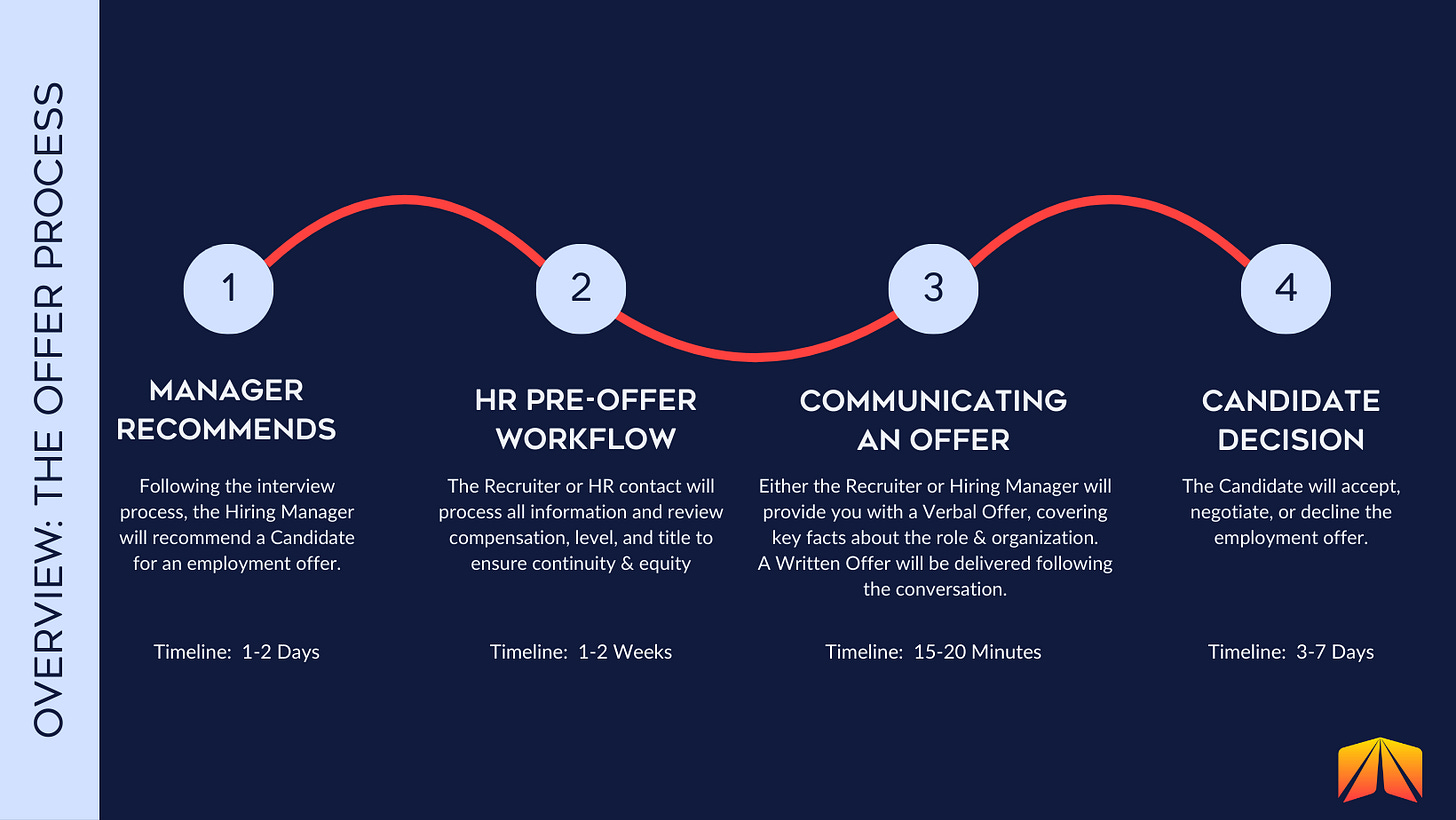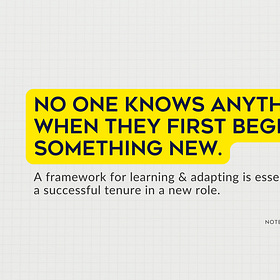On Launching Your Career: Receiving an Offer
Navigating the job offer with grace, tact, and strategic insight is crucial.
After rounds of applications, enduring the suspense of interviews, and overcoming the jitters of follow-ups, you've reached a pivotal milestone—receiving an employment offer.
This moment is the culmination of your hard work, perseverance, and the countless hours you've invested in launching your career. However, the journey doesn't end here. Here's how you can approach this exciting yet critical phase of your career journey:
Receiving an Offer: An Overview
Receiving an employment offer is one step in a larger process with your future employer. Understanding this process helps calm your nerves and provides a bigger picture to everything that is invested in you prior to joining an organization.
Step One: Manager Recommendation
The offer process kicks off at the end of the interview process. The Hiring Manager will make a recommendation for hire in conjunction with the Recruiter and Human Resources (HR) Manager.
In some organizations, this recommendation may require additional review or approvals from upper management or leadership team of the organization. If this is the case, it may take longer than the expected 1-2 days, depending on the review and approval cadence for the organization.
Step Two: Pre-Offer Workflow
Once the recommendation is approved, the Recruiter and HR team will kick off their internal processes to prepare an offer letter for the candidate. This team will gather all necessary information to make the offer as well as ensure the role meets the guidelines for title, level, and compensation.
Many organizations undergo an equity review to analyze the existing team members at that title, level, or role and ensure the candidate offer is within the expectations for existing team members. If there is an equity imbalance, this may be addressed and corrected before sending an offer to the candidate.
Step Three: Communicating an Offer
A quick meeting is scheduled with the candidate to communicate an offer verbally. This may be a video call or phone call with the Hiring Manager or with the Recruiter. This conversation will provide a high-level overview of the elements included in the offer and assess your enthusiasm for joining the organization.
This is a great opportunity to ask any questions about the offer and communicate your expectations.
Our experts recommend expressing enthusiasm and reviewing the full offer in writing following the conversation. While verbal acceptances are not enforceable in many states, it’s important to have written documentation for each element of your employment offer – and to understand exactly what you’re agreeing to as conditions to your employment.
Step Four: Candidate Decision
Candidates will have an opportunity to review the written offer and ask any questions about the offer. From there, candidates can accept the offer as-is, negotiate one or more specific elements of the offer, or decline the offer.
Often, there is a timeline set on this decision; a week is typical, but in faster-paced organizations, you may have only 72 hours to negotiate and make this decision. It’s important to understand each element of the offer to ensure it aligns with your expectations.
Understanding the Elements of the Offer
Before your decision, take a moment to fully understand the offer in front of you. An employment offer typically includes details about the salary, benefits, work schedule, starting date, and other terms of employment. It's important to carefully review all these elements to ensure they align with your expectations and needs.
Salary and Compensation
The salary is often the most focused-on aspect of a job offer, but it's just one part of the compensation package. Look for information about bonuses, stock options, and other financial benefits. Understanding the complete package is crucial for making an informed decision.
Start Date
Your start date is the day you are expected to start work at your new organization. In many cases, your start date will often reflect the necessary time to complete all pre-employment paperwork, background checks, and more. It will typically align to the normal onboarding or payroll cadence within the company. Start date is a negotiable element of your offer but be aware that you (and the organization) benefit when you join as part of a larger new hire cohort.
Benefits and Perks
Benefits can significantly affect your job satisfaction and financial well-being. Healthcare, retirement plans, paid time off, remote work options, and other perks should be considered alongside the salary. These elements contribute to your overall compensation and quality of life. Be sure to understand if there are contingencies to benefits eligibility; many organizations may require you to be part of the organization for up to ninety days (or longer) to be eligible for these benefits.
Job Role, Responsibilities, and Manager
Ensure that the job description outlined in the offer matches your understanding of the position and that it is reporting to the Hiring Manager you’ve previously interacted with. It's essential that you're clear about what will be expected of you and that you feel confident you can meet those expectations.
Additional Terms & Contingencies of Employment
This section of the offer letter will include information on pre-employment contingencies, background checks, probationary periods, confidentiality agreements, intellectual property agreements, non-compete agreements, and more. Ask questions of your Recruiter or HR representative to ensure you fully understand your employment agreement.
Signature
Once you agree to the offer, a signature is necessary to convey that agreement. A verbal agreement is not valid in many states. Expect to either print, sign, and return your offer agreement, or electronically sign a digital copy. Keep this signed agreement for your records.
Negotiating An Offer
If the offer isn't quite what you expected, remember that negotiation is a normal part of the process. Approach negotiation with a positive, cooperative attitude. Be clear about what you're asking for and why you believe it's reasonable.
Whether it's a higher salary, more flexibility in your schedule, or additional benefits, knowing the market rate for your role and having a rationale for your requests can strengthen your position.
Our experts recommend to negotiating at least one element of your offer. It is very rare to have a perfect employment offer, even for entry-level roles. Salary and other compensation is often a target for negotiation, but other benefits or perks may be more applicable for your situation. Be sure that anything agreed to is written and incorporated into your offer letter before you sign.
Prepare and Research
Before entering negotiations, research the standards for your role in your industry and region. Websites like Glassdoor, PayScale, and LinkedIn Salary can provide valuable insights. Having concrete data supports your negotiation points.
Express Enthusiasm
Let the employer know that you're excited about the opportunity but have some questions about the offer. This sets a positive tone for the negotiation.
Be Specific
Clearly articulate what adjustments you're seeking. Whether it's a higher salary, more vacation time, or remote work days, being specific helps the employer understand your needs and assess what they can offer.
Accepting An Offer
Once you've negotiated and are satisfied with the offer, it's time to officially accept. Acceptance should be done graciously, expressing your gratitude and excitement about joining the team. It's standard to provide your acceptance in writing, either through an email or a signed letter, which should reiterate the terms of your employment as you understand them.
Declining An Offer
Receiving an offer of employment is always a significant achievement, indicating that a company values what you bring to the table. However, there may be times when an offer doesn't align with your career goals, personal circumstances, or expectations. Declining an offer requires a delicate balance of honesty, professionalism, and tact. The key is to express your gratitude for the opportunity while making it clear that you are declining their offer and providing the reasons why.
To graciously decline an offer while keeping the door open for the future, consider the following approach:
Start by expressing sincere appreciation for the offer and the time the company's team spent interviewing you and reviewing your qualifications.
Acknowledge the effort they've invested in you.
Be clear and direct about your decision but avoid going into unnecessary detail about why the offer isn't right for you.
Focus on the positive aspects of your interaction with the company and leave room for future possibilities.
By crafting your message with gratitude and openness to future possibilities, you not only decline the offer respectfully but also leave a lasting positive impression. This approach ensures that the door remains open for future opportunities, whether in a different role or at a different point in your career.
Handling Multiple Offers
If you're fortunate enough to have multiple job offers, you'll need to weigh each against your career goals, values, benefits and compensation packages. It's important to communicate transparently with the employers. Letting them know you're considering multiple offers can sometimes work in your favor during negotiations, but it should be done delicately and honestly.
Embrace the Opportunity
Receiving a job offer is a significant achievement and a testament to your qualifications and potential. As you stand on the threshold of this new chapter, remember that how you handle this offer can set the tone for your career trajectory in the short and long term. Approach this moment with a mix of gratitude, strategic thinking, and self-advocacy. This is more than just a job offer; it's an opportunity to build the future you've worked toward.
Next Post:
On Your First Thirty Days: Onboarding & Integrating into a Company
Your first thirty days in a new role comes with a mix of excitement and nervousness. This first month will set the tone for your journey ahead: it’s about making a strong first impression, learning quickly, and laying the groundwork for long-term success.






